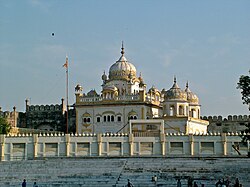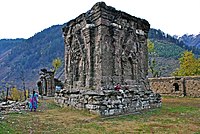
Nankana Sahib is a city and capital of Nankana Sahib District in the Punjab province of Pakistan. It is named after the first Guru of the Sikhs, Guru Nanak, who was born in the city and first began preaching here. Nankana Sahib is among the most important religious sites for the Sikh religion. It is located about 91 km (57 mi) west of Lahore and about 75 km (47 mi) east of Faisalabad. According to the census of 2017 the city has a population of 110,135 inhabitants. Until 2005, it was a part of the Sheikhupura District.

The Walled City of Lahore, also known as the Old City, forms the historic core of the city of Lahore in Punjab, Pakistan. The city was established around 1000 CE in the western half of the Walled City, which was fortified by a mud wall during the medieval era. It has been the primary cultural centre of the Punjab region since the late-medieval era.

Batala is the eighth largest city in the state of Punjab, India in terms of population after Ludhiana, Amritsar, Jalandhar, Patiala, Bathinda, Mohali and Hoshiarpur. Batala ranks as the second-oldest city after Bathinda. It is a municipal corporation in Gurdaspur district in the Majha region of the state of Punjab. It is located from holy city Amritsar 39 km and about 32km from Gurdaspur, the headquarters of the district. It is also a Police district. Batala holds the status of the most populated town of the district with 31% of the district's total population. It is the biggest industrial town in the district.

Sikhism is the fourth largest religion in Pakistan with a population of more than 15,000 Sikhs, mostly residing in Punjab and Khyber Pakhtunkhwa, accounting for 0.01% of the country's population. Sikhism has an extensive heritage and history in the country, although Sikhs form a small community in Pakistan today. Sikhism originated from what is now Punjab, Pakistan in the 15th century. Nankana Sahib, the birthplace of Guru Nanak, is located in Pakistan's Punjab province. Moreover, the place where Guru Nanak died, the Gurudwara Kartarpur Sahib is also located in the same province.

Majha is a region located in the central parts of the historical Punjab region, presently split between the republics of Pakistan and India. It extends north from the right banks of the river Beas, and reaches as far north as left bank of the river Ravi, constituting upper half of the Bari Doab.

Gurdwara Sis Ganj Sahib is one of the nine historical Gurdwaras in Delhi. It was first constructed in 1783 as a small shrine by Baghel Singh to commemorate the martyrdom site of the ninth Sikh Guru, Tegh Bahadur and was probably expanded after Indian Rebellion of 1857 or after Partition of India. Before its construction the Mughal Kotwali was situated here. After the Indian Rebellion of 1857 the Mughal Kotwali was demolished by the British and the land was given to the Sikhs as the maharaja of Patiala and other Sikh soldiers helped the British to defeat the Mughal soldiers by providing large numbers of ammunition and soldiers. Its current building was made by Rai Bahadur Narain Singh a contractor who build most of roads in Lutyens New Delhi construction under British Rule. Situated in Chandni Chowk in Old Delhi, it marks the site where the ninth Sikh Guru was beheaded on the orders of the Mughal emperor Aurangzeb on 11 November 1675. The Sikh regiment of the Indian army salute the Sis Ganj Gurudwara before saluting the president of India since 1979, the only instance of saluting twice in the Republic Day parade by a regiment of Indian army.

Nanakpanthi, also known as Nanakshahi, is a syncretist movement which follows Guru Nanak (1469–1539), the founder of Sikhism, but without necessarily formally identifying as being Sikh in terms of religious affiliation, as it's the case with numerous Punjabi Hindus and Sindhi Hindus. "Nanakpanthi" as a term is often used to refer to non-Khalsa Sikhs, some of whom may belong to Udasi orders but others are affiliated with other heterodoxical, non-Khalsa sects. In the broadest sense of the term, it simply refers to a follower of Guru Nanak's teachings and practices.

Sikh architecture is a style of architecture that was developed under the Sikh Confederacy and Sikh Empire during the 18th and 19th centuries in the Punjab region. Due to its progressive style, it is constantly evolving into many newly developing branches with new contemporary styles. Although Sikh architecture was initially developed within Sikhism its style has been used in many non-religious buildings due to its beauty. 300 years ago, Sikh architecture was distinguished for its many curves and straight lines; Keshgarh Sahib and the Harmandir Sahib are prime examples.
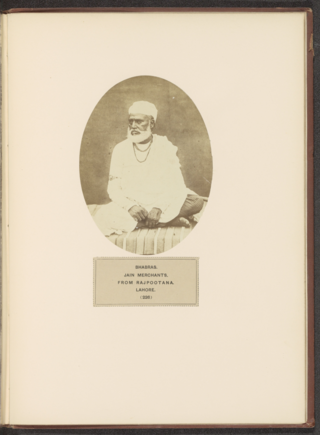
Bhabra or Bhabhra is an ethno-linguistic and religious group who are from Punjab region which follow Jainism.

Gurdwara Darbar Sahib Kartarpur, also called Kartarpur Sahib, is a gurdwara in Kartarpur, located in Shakargarh, Narowal District, in the Punjab province of Pakistan. It is built on the historic site where the founder of Sikhism, Guru Nanak, settled and assembled the Sikh community after his missionary travels and lived for 18 years until his death in 1539. It is one of the holiest sites in Sikhism, alongside the Golden Temple in Amritsar and Gurdwara Janam Asthan in Nankana Sahib.
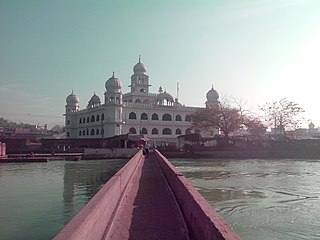
Kiratpur, also known as Kiratpur Sahib, is a town, just 30 km from Rupnagar city in Rupnagar district of Punjab, India. The town is the location of the Gurdwara Patal Puri where many Sikhs take ashes of their deceased.
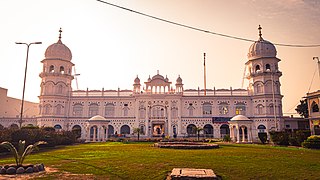
Gurdwara Janam Asthan, also referred to as Gurdwara Nankana Sahib, is a highly revered gurdwara that is situated at the site where the founder of Sikhism, Guru Nanak, was born. The shrine is located in Nankana Sahib, Punjab, Pakistan.

Jainism in Pakistan has an extensive heritage and history, with several ancient Jain shrines scattered across the country. Baba Dharam Dass was a holy man whose tomb is located near the bank of a creek called near Chawinda Phatic, behind the agricultural main office in Pasrur, near the city of Sialkot in Punjab, Pakistan. Another prominent Jain monk of the region was Vijayanandsuri of Gujranwala, whose samadhi still stands in the city.

Shaheed Ganj Mosque, originally named the Abdullah Khan Mosque, was a mosque in Lahore, Punjab, Pakistan. The Mosque was commissioned in 1722 during the reign of Mughal Emperor Muhammad Shah and built by Abdullah Khan. construction was completed in 1753 during the reign of Ahmad Shah Bahadur. It was constructed next to the shrine of Pir Shah Kaku. Sikh rule began in 1762, the Gurdwara Bhai Taru Singh was built afterwards within the same grounds. The mosque site was under dispute during British rule, but was demolished by Sikhs on the night of 8 July 1935.

Gurdwara Dera Sahib is a gurudwara in Lahore, Pakistan, which commemorates the spot where the 5th guru of Sikhism, Guru Arjan Dev, was martyred in 1606.
Gurdwara Shaheed Bhai Taru Singh or Gurdwara Shahidi Asthan Bhai Taru Singh ji is a Sikh Gurdwara at Naulakha Bazaar in Lahore, Pakistan, which commemorates the spot where Bhai Taru Singh was executed. The shrine was built on the grounds of the Shaheed Ganj Mosque, leading to a legal dispute over ownership that began in 1850. British, and later Pakistani, courts upheld the right of Sikhs to maintain a place of worship at the site. While a settlement was being negotiated by British authorities, a group of Sikhs demolished the mosque on 7–8 July 1935, triggering communal riots. In December 2022, Pakistan’s Evacuee Trust Property Board closed it to the public.
The Gurdwara Shahid Ganj Singh Singhania, also known as Gurdwara Shaheedganj Singh Singhnian, is a historic Sikh gurdwara at Naulakha Bazaar in Lahore, Pakistan, which marks the site where over 100,000 Sikh men and women lost their lives in the 18th century. It is located opposite Gurudwara Bhai Taru Singh. Bhai Mani Singh was martyred at this site on 14 June 1738.
